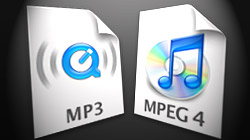There are a ton of misconceptions floating around about Apple’s use of the AAC audio codec in the iTunes Store instead of the more widely known MP3 format. A closer look reveals they’re making the right move.
The biggest myth out there regarding AAC is that it’s an Apple owned and controlled format. This couldn’t be further from the truth – it’s actually an international standard approved in 1997 by a number of other organizations unrelated to Apple. Anyone is free to license it, if they choose. The confusion was most likely spurred by Apple’s FairPlay DRM system, which locked down music files purchased on iTunes to a limited number of Apple-only devices. Since iTunes is now completely DRM-free, those limitations are gone.
But, still, confusion and mistruths remain. Even without DRM restrictions, a lot of people are under the impression that AAC is a proprietary format used by Apple to lock users into their iPods and iPhones. This is absolutely not true. The DRM-free AAC files now sold through iTunes are compatible with a wide range of competing devices such as the Microsoft Zune, Sony PSP, all of the current generation gaming consoles, and a number of mobile phones/PDAs. How can anyone claim AAC is proprietary when nearly all of Apple’s major competitors support it?
While all of this is good to know, it still doesn’t explain why Apple chose to go with AAC over MP3 in the first place. Put simply, AAC (which stands for Advanced Audio Coding) is the successor to the MP3 format. Its true name is MP4, which means that it’s next in the line of progress after its more common counterpart. Think of AAC as a new and improved version of MP3, because that’s exactly what it is. It boasts a more efficient compression scheme that helps save disk space, improve audio quality, and even increase battery life.
The main advantage AAC holds over MP3 is the promise of less quality loss at the same bit rates (and therefore the same file sizes), especially with files encoded at lower bit rates. To give you a better idea of what this means, Apple claims a 128 kbit/s AAC file should sound as good or better than a 160 kbit/s MP3 file. In the end you’re left with comparable or higher quality music and a smaller file.
In addition to the efficiencies of AAC, there are other pros to consider as well. Since it is a codec designed to address many of the inherent flaws of MP3, AAC offers more audio channels & frequencies and is generally more accurate & flexible. This is a big deal to the folks who create the music files because it gives them more control. Another factor that likely contributed to Apple’s decision to support AAC is the royalty fee companies are forced to pay for electronic MP3 distribution. Although both formats have similar general licensing fees, AAC does not require this additional royalty fee.
There’s a bunch more to talk about when you get down to the nitty gritty details of each codec, but that goes beyond the scope of this article. The main goal was to clear up any misconceptions users may have about AAC and why Apple does not sell MP3 files in the iTunes Store. While competing digital music stores like Amazon and Walmart may be MP3-only, that doesn’t mean Apple is trying to lock us in with a proprietary file format. They’ve simply made an informed decision to offer their customers the best value possible, while still allowing them to go outside the iPod + iTunes ecosystem if they choose.
Read more about AAC and MP3 on Wikipedia, as well as Apple’s own website.









